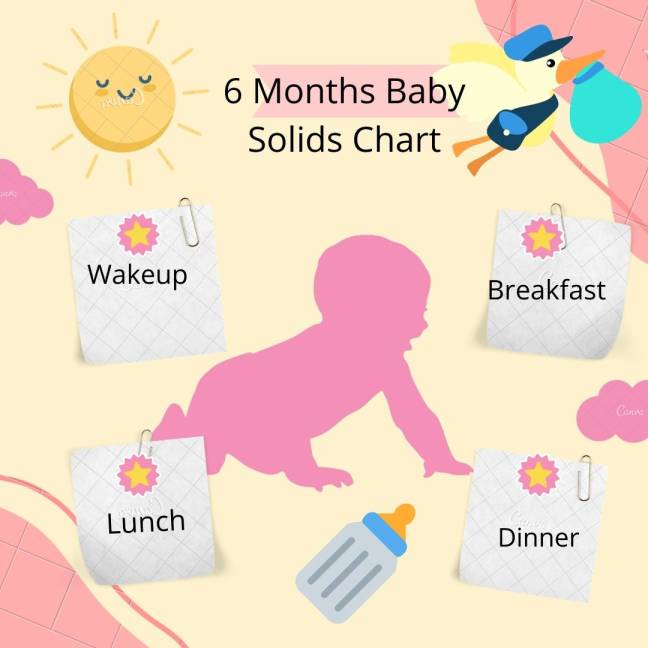Between the ages of 4 and 6 months, a baby develops digestive enzymes that are necessary for food digestion. It is prudent to wait until the kid fully develops these enzymes.
A baby normally develops head control between the ages of 3 and 4 months and strong head to neck muscles by the age of 6 months. A good head to neck control enables the baby to readily ingest foods and swallow them.
You may be wondering when to start the baby solids schedule? Thus, by six months, a baby’s digestive system and head control have improved, which are prerequisites for the introduction of solids.
Breast milk is the finest option for a baby’s overall growth. It is encouraged to breastfeed exclusively during the first six months of a baby’s life.
Formula milk is an exception for women who are unable to breastfeed owing to professional, personal, or medical reasons.
How do you determine whether your baby is ready to start the baby solids schedule?
- The head and neck of the infant are stable. This indicates that the infant is capable of accepting food and swallowing.
- The infant must be able to sit steadily with or without assistance.
- Demonstrates an interest in food as others eat.
- When food is presented to the baby, he or she must be able to open the mouth.
- After nursing or formula feeding, the baby is still hungry.
You can also refer to this site for further clarification.
Baby Solids Feeding Guide:
Consult your paediatrician first to determine whether your infant is ready for food. It is critical to plan carefully before introducing any meals other than breast milk.
Create your feeding guide and obtain consent from your physician for the items you wish to try. Additionally, the majority of clinics and hospitals include a diet chart or at the very least a suggestion.
This is based on instructions I obtained from clinics in India. I followed the same procedure with both of my infants.
- Always begin with one meal. A fruit, a vegetable, or a grain. Avoid combining foods. You may begin with mashed fruit. Fruits include digestive enzymes that aid in their digestion by the infant.
- After a week, while continuing to feed fruit, you can begin with rice water (kanji), followed by clear dal soup or boiling vegetable broth/water after another week.
- Always adhere to the three-day guideline when introducing new foods. Wait until the fourth day for the findings. Consult your paediatrician promptly if your infant develops rashes, a runny nose, watery eyes, or colic.
- During breakfast or lunch, introduce new foods to your infant. Avoid experimenting with new meals later in the day, when it is easier to regain control of the difficulties.
- A 7-month-old baby can initially consume only a teaspoon of mashed food. Increase the quantity gradually over four weeks to a tbsp and eventually more.
- For recommended CDC Guidelines
Suggestions for Introducing Baby Solids Guide:
- Prepare baby meals in stainless steel or glass dishes and cups. Avoid any plastic ware, even if it is made of a superior substance, such as virgin plastic or is BPA-free. Any type of plastic ware contains plasticizers that help the containers retain their flexibility.
- Plasticizers, like BPA, are endocrine disruptors. Chemical plasticizers are used in even BPA-free and virgin plastic goods. Please conduct a Google search for further information.
- Always feed the baby in a peaceful, quiet setting and from a stable position such as your lap, a high chair, or the floor.
- While the infant is nursing, keep him or her away from activities such as watching television, playing with a handheld device such as a mobile phone, tablet, or gaming device. Several of these generate radiation that is harmful to the infant.
- Mealtimes must be educational for the infant; conversing with him or her about the food – its texture, flavour, and colour – helps the baby acquire an appreciation for the meal. Alternatively, read a pleasant tale to the infant; avoid encouraging the baby to speak while eating. This may appear to be excessively strict, but it is the only approach I have discovered to raise fuss-free children. They will develop an appreciation for any cuisine offered.
- Use a steel cup or a glass to introduce water, not a feeding bottle or sipper. A 90 ml cup is ideal. This simplifies the transfer from teat to cup as the child grows older.
Baby Solids Chart For Six Months:
- To use this baby solids chart, please check when to start the baby solids schedule and that you have received consent from your physician and check your infant has reached the age of six months.
- A newborn typically takes milk every two to three hours. Between feeds, baby solids should be offered. If necessary, purée the fruits with ordinary boiling and cooled water. Take care not to combine milk or any other ingredient with fruit.
- The combination of fruit and milk products causes indigestion, lack of appetite, inability to gain weight, and toxic buildup.
- Clear soups can be used to produce rice, oats, or ragi cereals that are pureed. Regularly feeding transparent soups is not a good idea since they lack the nourishment offered by semi-solid food or milk.
This table to use if your infant is between the ages of 6 and 7 months.

Wake up Time – Breastfeed or use a formula milk substitute. Whatever time your infant awakens.
Breakfast – 7.30 – 8:00 a.m. pureed fruit (but only after 1 to 2 hours of milk consumption). You can make the purée with boiling or cooled water.
Recommendations for different fruit purees:
- Mash the bananas with a fork or puree in a blender.
- Peel, core, and steam one apple for approximately 5 to 6 minutes. In a blender, puree
- Sapota (chico) – mash with a fork and spoon
- Peel and core the pears and steam for 5 to 6 minutes.
- Papaya – mash with a fork or blender
- Avocado – purée in a blender
Lunch – From 11.30 a.m. until 12.30 p.m. Following the introduction of fruits, you can try these.
Recommendations:
The first week – Give rice cereal
The second week – apple rice or rice cereal with boiling carrots is recommended.
Third week – Ragi porridge adding apple or oats alternatively with a clear moong dal soup
The fourth week – Continue with the foods suggested previously. Additionally, you may incorporate soupy khichdi.
Remaining Hours– Breast milk or infant formula (only after 1.5 to 2 hours of lunch)


Nice
Very useful for younger generation
Well written content. List outs seems to be reliable. Keep writing. Best wishes.
Nice write up
Nice da.
Very usey
Good initiative. Informative.